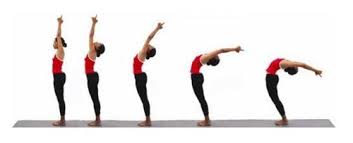Standing back bench pose

Step-by-Step
Begin by standing at the top of your mat in Mountain Pose with your feet hip-distance apart.
• Engage all of the muscles in your legs, focus on drawing your knee caps up. Keep your tailbone tucked under, belly drawn in, and heart forward.
• Release the tension in your shoulders and stand tall, reaching up through the crown of your head.
• Place the palms of your hands on your lower back, with your fingers pointing towards the ground, as you draw your elbows together.
• Take an inhale as you lift up tall through the crown of your head and focus on drawing your belly in, keeping your core strong.
• Exhale to arch your spine back, only go as far as feels comfortable for your body. You can keep your neck in line with your spine, looking forward, or drop your head all the way back.
Remain here for three to five breaths.
Focus on opening your heart as you deepen your backbend. Remember to keep your abs engaged and continue lengthening your spine.
When you are ready to exit the pose, inhale as you slowly return to Mountain Pose, stacking your spine one vertebrae at a time.
Use your palms on your back and your core to support you.
Tips and Modifications
Want to take this backbend a bit further? Once you come into the full extension of your Standing Backbend, you may feel comfortable releasing your hands from your back.
If this feels good, you can clasp your hands together releasing your pointer fingers towards the ground.
Another option is to clasp your hands above your head, reaching your point fingers towards the sky. Use your breath to bring you even deeper in your backbend.
As with any backbend, the most important part of practicing this pose is listening to your body.
The person on the mat to the right of you may be able to fold themselves in half backwards. The person on the mat to the left of you may bend back very slightly.
It’s important to remember that no matter what your backbend looks like, it feels like a healthy combination of challenge and comfort.
Note: Be especially careful performing a Standing Backbend if you have had any recent injuries to your neck or back.
The next time you step onto your mat with the intention of practicing your backbends, think about how you can incorporate Standing Backbend Pose into your sequence.
Benefits
Standing backbend is a wonderful heart-opening pose.
It helps to release tension, especially in the neck and shoulders.
This pose helps to open up the respiratory system for deeper, fuller breath.
Standing Backbend is also a fantastic preparatory pose for any deep backbend like Wheel, Bow or Camel pose.